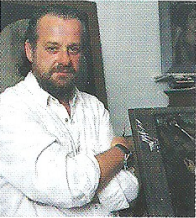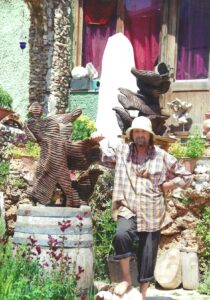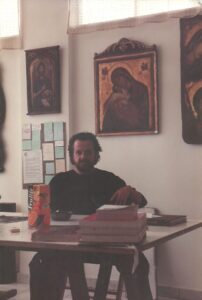 Spilios Tsounis was born in Kalavrita. From a very young age he studied as an intern for four years at the Athoniada Theological School, on Mount Athos. There he took his first hagiography lessons and was introduced to the secrets of painting by deep connoisseurs of traditional techniques. He had the good fortune to study at the Daniel family, close to the monk teacher Daniel, from whom some of the greatest names of modern Greek painting were taught, such as G. Tsarouchis, F. Kontoglou, etc.
Spilios Tsounis was born in Kalavrita. From a very young age he studied as an intern for four years at the Athoniada Theological School, on Mount Athos. There he took his first hagiography lessons and was introduced to the secrets of painting by deep connoisseurs of traditional techniques. He had the good fortune to study at the Daniel family, close to the monk teacher Daniel, from whom some of the greatest names of modern Greek painting were taught, such as G. Tsarouchis, F. Kontoglou, etc.
Therefore, it is clear that Spilios is one of the few remaining creators who owns and uses a wide range of old techniques, which they combine to deliver with astonishing results the strong pulse of today. Thus, his inspirations are reflected in his works with a completely personal style, sculpting with the tools of a majestic past, completely special modern forms.
Coming to Athens in 1971, he was taught graphic arts and decoration by the teachers D. Gratsias, N. Kakadiaris and the engraver V. Pantelakis and then he studied next to two great names of our century, G. Moralis and G. Mavroidis.
His love for art, in addition to his constant personal creation and search, cultivated in him a strong desire to transmit the precious essence of his knowledge to new talents. Thus he was for a number of years a professor at the Open University of Athens, as well as at the German School of Marousi.
His works have been presented in solo exhibitions in Athens and Thessaloniki, as well as in major cities in Greece and abroad. Especially at the Athens Biennale, which was organized in 1998 at the University of Economics of Piraeus, Spilios won the 1st prize. He has also been honored with the award of the Municipality of Athens in 1988.
His works are in the possession of many important Greek and foreign collectors.
Spilios has already completed the material of his next exhibition entitled "Spine Rhapsodies", a three-part exhibition that will combine the arts of painting, sculpture and poetry, with reference to the archetype. He hopes to present it wherever "the crunches of the heart tremble", perhaps even in distant Chile, where the soul of her once friend, Danais Stratigopoulou, travels forever.
Spilios' words
"MOMENTS (the word) means the points engraved on the map of fluid reality, as well as the indelible marks that life leaves on the body of the art work."
"Success also has a bitter taste, when in order to survive we sell-consume-eat all our values, our symbols - words and images. Let me (if I could) eat my art works in front of you."
"Art is a means of communication and changes the way we see the familiar objects. Art can enrich our experience not only when it elicits superior and high reactions but also when it provokes anger and hostility."
"I am satisfied with the actions in the real conditions of life, where the 'art and metabolism' of the surrounding reality tend to peaceful coexistence and communication."
"To love… to delight the heavenly gutter that floods your mind and sweat, excitement and exaltation."
"The essence of good is the proper use of the senses."





Has been said about Spilios
-
"Spilios' paintings are clearly the favorite meeting of two worlds. When the viewer stands in front of his works, he is simply fascinated by the rich offer of the past, wisely integrated in the dynamic search and deposition of today. This delicate balance, which is the supreme reference point in the whole of his creation, clearly refers to the artist's origins. Thus, starting at a very young age from Byzantine art and the traditional forms and techniques, he matured beyond knowledge and followed his instinct and personal quests that led him to a complete, complex and absolutely relaxing expression. Observing his works, paintings and sculptures, one can easily understand the torrent of Spilios' love for life and man. An incurably romantic person, he surrenders himself equally to the magic emitted by the lines of the human body and automatically his coffin loses its conventional limits; it becomes a new reality, a microcosm that pulsates with life and that hints at thoughts, reflections and dreams and the deepest desires of the artist, especially towards his fellow man. This immovable microcosm that pulsates in his works, consists of real persons - memories of the past - and persons of the future who embody the life-giving hope for a better tomorrow. The viewer encounters pain, observing faces engraved by the knowledge sculpted by the pain of the soul, but also redemption through airy faces, symbols of beauty and rebirth that the artist so persistently seeks. Other painting forms - symbols that are imprinted in his compositions are figures and heads of animals and human bodies, which are skillfully hidden behind the color contrasts and wait for the viewer to "penetrate" into the painting and discover them. His works move in the context of a dynamic abstract expressionism that sumplements and completes his existence through a number of symbols. I pollaplí chrísi tous kathós kai i diálysi kai diáspasi tis fórmas apeleftherónoun me trópo katalytikó tin kallitechnikí “agonía”, pou vrískei tin ektónosi kai ti dikaíosí tis stin apólyti ekfrastikí elefthería. Katópin, afínontas to synarpastikó paichnídi tis anakálypsis tou krymménou mikrókosmou, o theatís stéketai sto chróma pou ankaliázei kai “kamouflárei” prostateftiká ta mikroskopiká sýmvola, apokalýptontas parállila éna simantikó kommáti tis kallitechnikís psychís. San vási aplónontai oi skoúroi psychroí tónoi, oi opoíoi an kai kyriarchoún ston kamvá, diakóptontai aifnidiastiká óso kai efchárista apó enkáthetes thermés pineliés pou apofortízoun ti chromatikí sýnthesi. O Spílios zei me to skoúro pou apeikonízei entelós omá ton enklovismó tou simerinoú anthrópou kai lytrónetai me to anoichtó pou prosférei aisiódoxa minýmata sto pnigiró adiéxodo. Étsi, loipón, aftí i adiákopi enallagí apó to skotádi sto fos, i atérmoni páli anámesa sto mov kai sto kókkino, i poreía pros to thánato pou synantá to páthos, ti fotiá kai ti génnisi schimatízoun stous pínakes tou Spíliou tin ídia ti zoí, pou anagennátai apó tis stáchtes tis, metamorfónontas to cháos se armonía. O kallitéchnis apofévgei tin profaní prooptikí, dióti epithymía tou eínai na topothetísei o theatís tis morfés kai ta sýmvola stin dikí tou optikí skakiéra kai na katathései tis dikés tou sképseis kai provlimatismoús dípla se ekeína tou dimiourgoú. Étsi katalavaínei kaneís óti ta érga tou Spíliou, chrisimopoióntas tin dýnami ton morfón kai tou chrómatos, katalígoun na gínontai énas diálogos anámesa stin psychí theatí kai kallitéchni kai na metaféroun aisiódoxa minýmata pou metamorfónontai se chróma kai prósopa se énan kamvá pou ousiastiká den échei archí kai télos.» Show more 1709 / 5000 Translation results Their multiple use as well as the dissolution and disintegration of the form catalytically release the artistic "agony", which finds its relaxation and its justification in the absolute freedom of expression. Then, leaving the fascinating game of discovering the hidden microcosm, the viewer stands in the color that embraces and "camouflages" carefully the miniature symbols, while revealing an important part of the artistic soul. As a base, the dark cool tones are spread, which, although they dominate the canvas, are interrupted abruptly and pleasantly by settled warm touches that discharge the color composition. Spilios lives with the dark that depicts completely raw the confinement of today's man and he is redeemed with the open that offers optimistic messages to the suffocating impasse. So, this uninterrupted alternation from darkness to light, the endless struggle between purple and red, the path to death that meets passion, fire and birth form in Spilios' paintings the very life that reborn from its ashes, transforming chaos into harmony. The artist avoids the obvious perspective, because his desire is for the viewer to place the figures and symbols on his own visual chessboard and to submit his own thoughts and reflections next to those of the creator. Thus one understands that the works of Spilios, using the power of forms and color, end up becoming a dialogue between the soul of the spectator and the artist and conveying optimistic messages that are transformed into color and faces on a canvas that has virtually no beginning and no end.»
Dimitra Ioannou
Art Historian -
"In his art, the experience of postmodernism restores the narrative of any subject, while the intense manifestations of realism are depicted vividly, subverting relevance, qualities and associations. The inspired artist conveys through allegorical correlations a visual parade of inspirations. Completing a cycle of compositions as a creator, he sturdily produces coherently beautiful shapes, while his quests are evident as they are distinguished by authenticity and honesty of writing. Building a peculiar field of vision, T. Spilios combines decorative motifs, polyhedral shapes, full masterful elements, perpetuating the view of sequence, completeness, unification and stylization. "
Leodios Petmezas
Theoretical art historian -
"Spilios Tsounis is a young man with magical hands, with a sensitivity that I can not find a word to describe. He is a boy who takes a piece of olive trunk and makes it a dream, a philosophical saying or a tangible life. A sculptor, photographer, painter, hagiographer but also a teacher worried about the visual arts of young people, he received me in the small temple of his art simply, as simple as the material he held and carved with paternal love. He must exhibit his wonderful hagiographies, his unique wood carvings, intricate and allegorical compositions and make the world around him embrace art even more. " Spilios, as his friends gracefully call him, is the favorite child, the tender friend and Master of Arts and the "Magic Artist". If he lived in Chile - where wood is a blessed material for its sculptors - they would have deified him. But, above all, and beyond everything, he is Greek in width, depth and height. He is Greek in what he does and - before that - in what he thinks. We are waiting for his justification. Panhellenic… and not only. "
Danai Stratigopoulou
Musician -
Η ποίηση του Σπήλιου Τσούνη είναι τέχνη που εκπορεύεται από τη ζωγραφική και τη γλυπτική και την πατροπαράδοτη σοφία της Ανατολής. Ο ποιητής, χαμηλών τόνων, αποπνέει το άρωμα των αρχαίων μυστών και την ευλάβεια των μυστικών της ορθόδοξης ελληνικής παράδοσης. Η ταπεινοφροσύνη, αφήνει το αίσθημα του πόνου και την τραγικότητα της ύπαρξης να γίνει συντριβή και ικεσία. Λιτότητα έκφρασης και συμπυκνωμένη συγκίνηση επιτρέπει στον ποιητή να συμμετέχει στην κοινή ανθρώπινη μοίρα. Μοναχικός αλλά ορθάνοιχτος στον κόσμο αφουγκράζεται και παρατηρεί τη ζωή και όπως οι πραγματικοί ασκητές εμφανίζεται εν καιρώ με τα έργα του, όπου αφηγείται, ξεδιπλώνει τη μνήμη και αναμετρέται με τη μοίρα του προσπαθώντας να επιστρέψει στην ποθητή Ιθάκη. Ο λυρισμός του ξεδιπλώνεται σ’ένα δίπτυχο σπονδυλωτών και ραψωδιακών ποιημάτων. Στα πρώτα συνωθούνται τα εγκόσμια και υπερβατικά, οι εμπειρίες οι χαρμολύπες και τα παθήματα του βίου ενώ στα δεύτερα ξεδιπλώνεται η τρυφερότητα του έρωτα και γίνονται όλα ένα άσμα-ασμάτων. Ο ποιητής, καθ’ομολογία του, άβολος και ονειροπαρμένος, πιάνεται από τα στέρεα, ακατάλυτα και πανάρχαια υλικά, πέτρα και ξύλα και γίνεται ραψωδός, υμνωδός και νοσταλγικός μιας άνοιξης που “κρέμεται απ΄τον ουρανό του” ενώ μας καλεί να ακούσουμε το τραγούδι του με τα σύμβολα και τη μυθολογία του. Βαθιά ελληνικός και συνάμα οικουμενικός, ξετυλίγει το κουβάρι της Αριάδνης, αναμετριέται με το χρόνο και ταλαντεύεται ανάμεσα στη ζωή και στο θάνατο. Παγανισμός και χριστιανισμός συμπλέκονται και αλληλοσυμπληρώνονται: η προσευχή στη Δέσποινα και στον Ουρανό συμβαδίζει με τον όρκο στην αγράμπελη της ξερολιθιάς. Ο ποιητής πραγματικός δημιουργός κι αυτός, δίνοντας πνοή ζώσα σ’έναν κόσμο δέντρου, σε μια πέτρα, σ’ένα πεταμένο βαρέλι και σε όποιο άλλο “ταπεινό” υλικό, πλάθει από την αρχή τον κόσμο.
Δημήτρης Πιστικός
Ποιητής - Κριτικός Ποίησης -
"Before Spilios starts his research in wood sculpture and painting, he had acquired an important tenure in the field of Byzantine hagiography. His nature was revealed gradually and in depth, with the result that for many years he considered himself completely dependent and essentially connected to it. Odoiporeí kai paratireí, afounkrázetai kai synomileí me diáfores ópseis kai morfés tis fýsis, aná óres kai epochés, epilégontas kormoús, xerá kladiá, thalássia xýla kai antikeímena pou échoun proélthei apó fysikés diergasíes sympliroménes apó ekeínes tou víou ton anthrópon í tou chrónou. Óson aforá stin glyptikí tou, ekeíno pou kentrízei to endiaféron kai tin fantasía tou eínai i yfí, to chróma kai ta “nerá” tou xýlou, oi antistáseis kai oi symperiforés tou, oi diáfores “peripéteies” tou ylikoú pou ypodilónoun tis epenérgeies tou klímatos, ton synthikón anáptyxis ton fytón kai ton trópon pou syndyázontai oi nomotéleies me tin peristasiakótita allá kai tin paradoxótita, katalýontas tis ópoies desmeftikés eklogikéfseis. Ta “evrímatá” tou eínai kormoí apó déntra eliás, lemoniás, kerasiás, péfkou, k.a. Oi eikastikés epemváseis tou, páno s’ aftá ta “evrímata” pou metamorfónontai, eínai cheironomiakés, apeleftherónontas o kallitéchnis af’ enós tin scholastikótitá tou, afetérou tin fantasías tou. Sta érga tou syndyázei ton cheironomiakó expresionismó kai tin yperrealistikí diáthesi. Ta xýla tou gínontai “sómata kamónton”, kravgés kai psíthyroi, elpídes kai páthi, mnímes kai anatropés, pedía esoterikís pális kai morfikís anáplasis, antithéseon kai enarmoníseon pou ypomnimatízoun gegonóta, ópos aftá tis génnisis, tou érota kai tou thanátou. Ta glyptá tou leitourgoún ston chóro evetiriaká kai taftochrónos apotropaïká, san “fylaktírioi daímones” pou enónoun tin dramatikótita me to eftrápelo, to tychaío me to moiraío kai to anapótrepto me tin ypervatikí aísthisi. O Spílios psávei tis epifáneiés tou. Tis parakoloutheí me to skalídi tou, kathós synechízei kai proekteínei me to chéri tou tis poreíes kai ta aprosdókita “monopátia” tis fýsis. Ekeí pou teleiónei i fýsi, archízei o kallitéchnis, – chorís na tin paraviázei – na yiotheteí éna eídos noerís synécheias pou exatomikévei morfómata, mésa apó ta opoía o ídios afairetiká mas anakalýptei prósopa kai prágmata, schéseis kai alligoríes, pragmatikótites kai metafysikés paramétrous, esoterikés allilouchíes aptótitas tis yfís kai ton ónkon sta glyptá tou pou synomiloún me ton chóro kai tis kymainómenes tonikótites tou fotós, katá tin diárkeia tis iméras.» Show more 2188 / 5000 Translation results He walks and observes, listens and converses with various aspects and forms of nature, by hours and seasons, choosing trunks, dry branches, marine wood and objects that have come from natural processes complemented by those of human life or time. Óson aforá stin glyptikí tou, ekeíno pou kentrízei to endiaféron kai tin fantasía tou eínai i yfí, to chróma kai ta “nerá” tou xýlou, oi antistáseis kai oi symperiforés tou, oi diáfores “peripéteies” tou ylikoú pou ypodilónoun tis epenérgeies tou klímatos, ton synthikón anáptyxis ton fytón kai ton trópon pou syndyázontai oi nomotéleies me tin peristasiakótita allá kai tin paradoxótita, katalýontas tis ópoies desmeftikés eklogikéfseis. Ta “evrímatá” tou eínai kormoí apó déntra eliás, lemoniás, kerasiás, péfkou, k.a. Oi eikastikés epemváseis tou, páno s’ aftá ta “evrímata” pou metamorfónontai, eínai cheironomiakés, apeleftherónontas o kallitéchnis af’ enós tin scholastikótitá tou, afetérou tin fantasías tou. Sta érga tou syndyázei ton cheironomiakó expresionismó kai tin yperrealistikí diáthesi. Ta xýla tou gínontai “sómata kamónton”, kravgés kai psíthyroi, elpídes kai páthi, mnímes kai anatropés, pedía esoterikís pális kai morfikís anáplasis, antithéseon kai enarmoníseon pou ypomnimatízoun gegonóta, ópos aftá tis génnisis, tou érota kai tou thanátou. Ta glyptá tou leitourgoún ston chóro evetiriaká kai taftochrónos apotropaïká, san “fylaktírioi daímones” pou enónoun tin dramatikótita me to eftrápelo, to tychaío me to moiraío kai to anapótrepto me tin ypervatikí aísthisi. O Spílios psávei tis epifáneiés tou. Tis parakoloutheí me to skalídi tou, kathós synechízei kai proekteínei me to chéri tou tis poreíes kai ta aprosdókita “monopátia” tis fýsis. Ekeí pou teleiónei i fýsi, archízei o kallitéchnis, – chorís na tin paraviázei – na yiotheteí éna eídos noerís synécheias pou exatomikévei morfómata, mésa apó ta opoía o ídios afairetiká mas anakalýptei prósopa kai prágmata, schéseis kai alligoríes, pragmatikótites kai metafysikés paramétrous, esoterikés allilouchíes aptótitas tis yfís kai ton ónkon sta glyptá tou pou synomiloún me ton chóro kai tis kymainómenes tonikótites tou fotós, katá tin diárkeia tis iméras.» Show more 1906 / 5000 Translation results As for his sculpture, what arouses his interest and imagination are the texture, the color and the "water" of the wood, its resistances and behaviors, the various "adventures" of the material that suggest the effects of the climate, of plant growth conditions and the ways in which laws are combined with occasionality but also the paradox, catalyzing any binding rationalizations. His "findings" are trunks of olive, lemon, cherry, pine, etc. trees. His artistic interventions, on these "findings" that are transformed, are gestural, releasing on the one hand the artist's meticulousness, while on the other hand his imagination. In his works he combines gestural expressionism and surreal mood. Its woods become "bodies of doers", screams and whispers, hopes and passions, memories and upheavals, fields of internal struggle and formal regeneration, contrasts and harmonizations that commemorate events such as those of birth, love and death. His sculptures operate in the art area, in an euphoric and at the same time apotropaic way, like "amulet demons" that unite drama with the subtle, the accidental with the fatal and the inevitable with the transcendental sense. Spilios scrubs its surfaces. He watches them with his ladder, as he continues and extends with his hand the paths and the unexpected "paths" of nature. Where nature ends, the artist begins - without violating it - to adopt a kind of mental continuity that individualizes formations, through which he abstractly discovers persons and things, relationships and allegories, realities and metaphysical parameters, internal texture tangibility sequences and volumes in his sculptures that converse with space and the fluctuating tones of light, during the day."
Athena Schina
Art Critic and Historian -
"The tradition that continues dynamically today is the expression of a brilliant course of Greek art from the Hellenistic era until today. The mural, the portable image as well as the passage (stylistically) in our painting suggests that we stand poetically in front of the creator in an aesthetic integration, identified with the spirit of our ancestors. The creative combination of the painter's breath with the poetic dimension and with the spirit of the performance and the color leads to the ascension far beyond. Spirituality and sensuality, time and timelessness, reality and poetic mood, expressiveness and liveliness are some of the characteristics of the works, worked in wood on the basis of various techniques. The daring that undertaken by the artist to create works that bear the marks of past and not only eras, and the choice of the specific types reveal once again the stable and if one pays better attention, common to all background works, that of intense reflection on the role and purpose of art today. This is a very careful work with frescoes, Fayum, hagiographies, art works of expressionist abstraction but also realism. The idea that in every artistic result there is the relation of nature (as reality) with the artistic creation (which has poetic elements) is perhaps the hidden truth of art. When one considers that art is not the application of a rule of beauty but what is captured by the instinct and the mind of the creator beyond the rule, one experiences feelings of satisfaction and frustration at the same time, every time one comes in contact with art works that speak to the eye and the soul. It feels satisfying because the work of art presents coded timeless ideas that delight. He feels frustrated because he knows that the void created by art will not exist soon if he does not take care to fill it."
Dimitra Sarri
Art Critic and Historian -
"What characterizes the work of Spilios, is the power in his color range, as well as the comfort with which he treats and uses the various materials. Sometimes he uses pastels, while others oils or even mixed techniques, such as powder, glue and more, everything takes on a force and an "aggressive" dimension in the artist's hand, a dimension that comes out of his work. Aggressive and at the same time polished. Strong and at the same time poetic. They are the messages of the visual language of Spilios."
Nelli Spiliopoulou
Journalist -
"You visit your friend for a cup of coffee and you find him chatting with a snail - to scold it rather better - who has been diligently chewing the sprouts of his garden. And you are not surprised, since that friend happens not to discriminate in his intercourse and he could, that easy, discuss with a cyclamen, let's say, - or with a cloud - depending. Maybe with this behavior Spilios serves his ultimate goals. In other words, with this way he gains the trust of his paradoxical interlocutors, according to an expression of the great Danae "everything that falls into his hands - soil, stone, water, wood, metal, even what many count as garbage - to transform it into shape, color, idea, beauty ”. Because Spilios, apart from being a renowned painter and sculptor, belongs, among others, to this special group of creators who express to the absolute degree the meaning of the artist. Paidáki akóma, ki enó chánontan me tis óres parakolouthóntas ta fantastiká schédia pou skárone i ygrasía sta tavánia, katáferne n’ apospá tin évnoia ton daskálon tou – me tous omirikoús íroes kai tous Megaléxandrous pou zográfize ston pínaka – isoskelízontas m’ aftón ton trópo ta anamenómena provlímata pou dimiourgoúse “to apeítharchon” tou charaktíra tou. Ki ótan argótera stin Kallón Technón oi dáskaloí tou sa na dysthymoúsan m’ aftí tou tin apeitharchía, érchontan gi’ antistáthmisma to endiaféron kai o thavmasmós ton symmathitón tou na tou parastathoún sti monachikí poreía pou tou epévale to kosmokalogerístiko taperaménto tou. Show more 620 / 5000 Translation results As a child, while lost for hours watching the fantastic drawings of the humidity on the ceilings, he managed to win the favor of his teachers - with the Homeric heroes and the Alexander the Great he painted on the board - thus balancing the expected problems created by the "unruly" of his character. And when later in the Fine Arts his teachers seem to displeased with this disobedience, a compensation was the interest and admiration of his classmates to support the lonely course imposed on him by his cosmopolitan and nun-like temperament. - Schools and teachers provide you information that if they are properly fermented with your life and metabolized into what they call soul, only then there is the possibility they become knowledge. Me again, he continues, taking into account primarily the character of the artist (what metal he is made of) I believe in the conjunctures. In those components that, coinciding with time and need, determine your evolution. But at the same time I learned that there are obstacles to be tested, to keep us awake. I ask his opinion about what is the most risky thing for an artist. - To believe that he conquered a peak and the repetition. Repetition is the death of the true artist, he adds. I still ask him to clarify his relationship with painting and sculpture respectively. - I am a painter every hour of the day, every moment. In sculpture, on the other hand, I always wait for her call. When, let's say, the olive tree will decide to speak to me. Then I start working on her, chasing her. - What do you mean by chasing her, Spilio? - I do not use clamps. So I let the wood do its thing - which it would do anyway - and lead me to its hidden forms. - And when do you decide to finish a project? - So, let me tell you something that was revealed to me over the years. When the saliva in my mouth becomes as sweet as honey. Then I know that the project has now taken its final form. Leaving, Spilios cuts a round cabbage and gives it to me. - It does not belong to the snail. That's another. "
Periklis Cheilas
Artist

